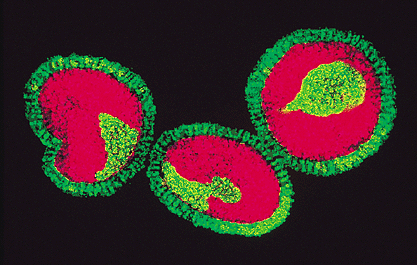Scientists Create Controversy with Deadly Virus
June 16, 2014
In a series of controversial experiments, scientists at the University of Wisconsin in Madison have re-created in a laboratory a strain of influenza virus that closely resembles the virus responsible for the Spanish flu pandemic (global occurrence) of 1918 that killed over 50 million people worldwide. The scientists contend that they re-created the deadly virus as a necessary step to help combat future flu pandemics. However, critics of the research argued that the experiments should be halted immediately as they pose a great threat to public safety.
Influenza tends to occur in widespread epidemics that occur most every year. Each outbreak is caused by a virus slightly different from earlier ones. Some strains (types) cause mild or moderate illness, and others cause many deaths. The Spanish flu of 1918 was the deadliest outbreak of influenza in history. Medical historians believe the Spanish flu virus, like many strains of influenza, probably originated in Asia. The disease quickly spread to the United States, Europe, Africa, and South America. During the height of the pandemic, the huge number of deaths severely disrupted many societies. Less severe pandemics occurred in 1957 and in 1968 but still resulted in many deaths.

Influenza viruses (shown here are greatly magnified and artificially colored) may cause flu when they are inhaled. (© Linda Stannard, UCT/SPL from Photo Researchers)
The Wisconsin scientists, led by Yoshihiro Kawaoka, isolated several genes from influenza viruses that normally infect wild ducks in Asia. These “avian influenza” (also known as “bird flu) viruses often mutate so they can infect mammals, including humans, and spread in global pandemics. Using a technique known as “reverse genetics,” the scientists used the individual genes to reconstruct an entire flu virus. They compared this rebuilt virus to virus samples from frozen corpses of victims of the 1918 Spanish flu pandemic recovered in Alaska. The rebuilt virus was 97 percent identical to the deadly Spanish flu virus.
The scientists infected ferrets with the re-created virus so they could study how it infected and spread among mammals. Kawaoka contends that such experiments are important so scientists can understand why the 1918 Spanish flu virus was so lethal, compared to other strains of flu that originate in wild birds. For example, the scientists identified a mutation in the rebuilt virus that enabled it to spread more easily from one animal to another. Scientists argue that continued research will help them better understand how the virus infects animals and makes them ill. This information will be useful for developing effective vaccines and treatments to combat future flu pandemics.
Other scientists argue that the research is too dangerous to continue and that another Spanish flu pandemic is unlikely to occur naturally. They claim that the most serious risk lies with the rebuilt virus being released from the high-security laboratory through some accident. Should an infected research animal escape, the deadly virus could spread rapidly in a new global pandemic with catastrophic results. The United States National Institutes of Health (NIH) which funds the controversial research, insisted that proper safety measures are being taken and that funding for the research would continue.
Additional World Book articles:
- SARS
- Swine flu
- Influenza: A New Threat from an Old Foe (a Special Report)
- Medicine in the 21st Century: The Promise of Genetics (a Special Report)


